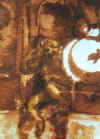|

With the kind
permission of the Italian Ministry of Cultural Works and Activities. Reproduction or
duplication prohibited.
As the only evidence for the missing monkeys comes from the Uffizi
pen and wash drawing and its authenticity has never been doubted it ought to be studied
carefully because it gives information regarding the pose of the monkeys and clues as to
their position within the niche. The drawing confirms clearly enough in the position of
the legs that the monkeys are in two poses, therefore we know there cannot be four
identical monkeys on the fountain. The drawing does not show the monkeys in four separate
poses, there are only two monkeys visible and we have to deduce the pose of the two not on
view using information, such as precedence. Giambologna may have wished to use a
successful format. The monkeys in the drawing have been given a brown wash.
The monkey to the left
of the drawing shows the right arm raised, finger pointing up and the left arm held out
horizontally, the hand cupped. (Only an enlargement of the drawing revealed this cupped
hand, with fingers visible.) The right hand monkey in the Uffizi drawing may well have the
same arm and hand positions as the left monkey but the right leg is raised, the left leg
lowered which is the exact reverse of its companion.

The drawing shows both monkeys sit partly outside the niche and
their heads do not extend into the arched part of the niche. The Uffizi drawing shows
three brackets or ledges attached to the outer wall which might be for carrying purposes
(they could be steps) as perhaps the drawing was a copy of a model of the fountain in the
studio. It is known that Giambologna took models of fountains to his patron for approval,
and the existence of other designs for this fountain, with brackets present, may confirm
the patron was given a choice. The outer wall of the fountain now at Aranjuez is circular
in shape whereas it can be seen in the Uffizi drawing as square. Even if the outer wall
now at Aranjuez is not the original installed in Florence it demonstrates when a drawing
is a preparatory sketch for a client we can allow for differences in final execution. As
the fountain was dismantled in 1584, the monkeys removed, it seems unlikely the Uffizi
drawing can be dated to circa 1600 but more likely to be a sketch of the fountain to show
to the patron before the commission was executed.
The sculptor with
a model of a fountain

Recent research seems to indicate that the
outer wall of the fountain, now at Aranjuez, could well be the original, for the Tuscan
Ambassador to Spain, Guicciardini, stressed the fountain should be sent complete as there
was no marble or competent marble workers who would know how to set it up. (12)
|